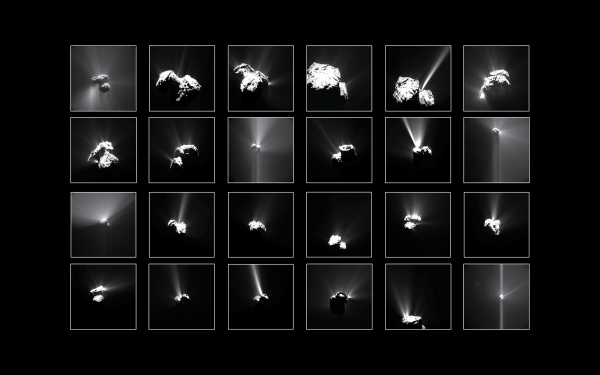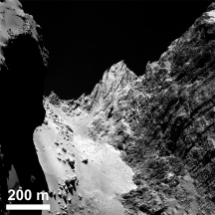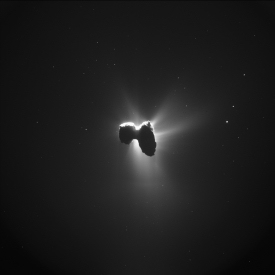The surprising comet
26 September 2016
As Rosetta began homing in on Comet 67P/Churyumov–Gerasimenko in the weeks leading up to its arrival in August 2014, it became very clear that this was no ordinary comet. But its striking shape was only just the beginning of the comet's surprises. After more than two years spent living with the comet, Rosetta scientists reflect on some of the mission's unexpected discoveries, the mysteries solved and the new questions raised. |
| Comet outbursts. Credit: OSIRIS: ESA/Rosetta/MPS for OSIRIS Team MPS/UPD/LAM/IAA/SSO/ INTA/UPM/DASP/IDA; NavCam: ESA/Rosetta/NavCam – CC BY-SA IGO 3.0 |
"Rosetta has completely changed our picture of comets," says Eberhard Grün, an interdisciplinary scientist working on the Rosetta mission at the Max Planck Institute for Nuclear Physics in Heidelberg, Germany.
"Previously, they were pictured as dirty ice balls – or, as some prefer, icy dust balls – but now we know them, or at least this one, to be geologically complex worlds where a myriad of processes are at work creating the incredible surface structure and activity of the comet."
While many of the results from the mission highlight the findings of individual instruments – 11 on Rosetta and 10 on Philae – the role of the interdisciplinary scientists is to keep abreast of the findings of the entire mission, and see how the different results fit together and develop a more comprehensive view of how the comet 'works'.
"It is only really in the last few months that it felt like all the pieces of the puzzle were falling into place without effort, and step-by-step it is becoming clearer which of our results are the crucial keys to deciphering the 'Rosetta stone' we have in our hands," says Marco Fulle, also a Rosetta interdisciplinary scientist, based at the National Institute of Astrophysics, Trieste, Italy, and lead author of a paper summarising a number of the most unexpected and significant findings made in the first two years of data analysis.
One big open question concerned the origin of comets. "This was one of the things I was really looking forward to finding out about: just how primordial are comets?" says Bonnie Buratti from NASA, who acts as their project scientist for Rosetta.
 |
| Profile of a primordial comet. Credit: Centre: ESA/Rosetta/NavCam – CC BY-SA IGO 3.0; Insets: ESA/Rosetta/MPS for OSIRIS Team MPS/UPD/LAM/IAA/SSO/INTA/UPM/DASP/IDA; Fornasier et al. (2015); ESA/Rosetta/MPS for COSIMA Team MPS/CSNSM/UNIBW/TUORLA/IWF/IAS/ESA/ BUW/MPE/LPC2E/LCM/FMI/UTU/LISA/UOFC/vH&S; Langevin et al. (2016) |
"With the data presented so far, the comet certainly looks pretty primordial, offering us a glimpse of what the building blocks of the planets and moons may have looked like, 4.6 billion years ago."
Results from Rosetta so far indicate that comets are likely ancient leftovers of early Solar System formation, and not younger fragments resulting from subsequent collisions between other, larger bodies.
Where was the comet born?
"One of the most unexpected and important discoveries was that of molecular oxygen," says Marco. "Combined with the detection of molecular nitrogen, noble gases and the value of the D/H ratio in the comet's water, this tells us that the comet was born in a very cold region of the protoplanetary nebula, far from the Sun."
Nitrogen and oxygen in particular need low temperatures to be trapped in the comet's ices, so the fact they are observed outgassing today along with water vapour suggests they were incorporated into the comet during its formation.
 |
| Deuterium-to-hydrogen ratio in the Solar System. Credit: Data from Altwegg et al. 2014 and references therein |
The ratio of deuterium – an isotope of hydrogen with one additional neutron – to normal hydrogen found in the comet's water holds other important clues to the conditions in which the comet was born.
Theoretical simulations indicate that this ratio should change with distance from the Sun and with time in the first few million years of Solar System history. Since the ratio does not change during a comet's life, it is an important indicator of the conditions at the time of the formation of its constituent ingredients, and therefore where the comet was most likely born.
The ratio has been measured for 11 comets, mainly via remote observations, and Rosetta's comet has the highest of them all. This suggests that comets formed over a much wider range of distances from the Sun in the young Solar System than previously thought.
Rosetta's measurement of the ratio was also one of the most anticipated results of the mission for another reason: its direct link to the source of Earth's oceans. Was water brought to our planet by comets or asteroids? Rosetta found that its comet's water is quite different to that of Earth's, and indeed of other comets and asteroids too, again indicating a diverse origin.
"The essence of the question has changed," says Bonnie. "Now we have to ask: what fraction of the water on Earth came from comets, how much came from asteroids or other bodies, and how much was here to begin with?"
"We have made great progress in starting to address the big questions Rosetta set out to answer, but full answers will take time," says ESA's Rosetta project scientist Matt Taylor.
"We have already made inroads into the composition and characterisation of the comet coma. We've also studied the surface of the nucleus in great detail, started to classify surface features and regions, and now we're trying to understand these surface features at a range of scales."
 |
 |
| Philae at Abydos. Credit: ESA/Rosetta/Philae/CIVA | Hathor. Credit: ESA/Rosetta/MPS for OSIRIS Team MPS/UPD/LAM/IAA /SSO/INTA/UPM/DASP/IDA |
"Similarities between the scene captured by Philae at its final resting place in Abydos at millimetre-scale and those seen in the Hathor cliff by Rosetta at metre-scale are incredible," adds Eberhard. "They demonstrate that there is a lot for us to understand about how various physical processes work at different scales, as well as the properties of the material we are looking at."
Comet shape in control
The shape of the comet and the features on its surface play a role in its activity, driving its seasons, dust transport and influencing the gas densities observed in the coma.
"The comet shape is extremely important to link what we see on the surface of the nucleus to our observations of the coma using both Rosetta's in-situ instruments and remote sensing," says Marco.
"Many teams in the Rosetta community, not just the instrument scientists, but also observational astronomers and experts in computer modelling, have been working hard on this topic, and it is a nice surprise to see that their results are in very good agreement: this is not trivial when such a challenging problem is faced for the first time."
For a comet that is constantly changing, this one is apparently doing so with persistent regularity. The comet has been the subject of much attention from Earth-based astronomers, who have recorded similar patterns of behaviour in its activity as it repeats its 6.5 year orbit around the Sun.
"We now know that this is related to the shape of the comet, and the way the release of gas from the two lobes distributes internal stresses between the body and head. This allows the spin axis to remain well fixed in space, which in turn means regular seasons and repetitive behaviour along the comet's orbit," says Marco.
Owing to its double-lobed shape and the inclination of its rotation axis, the comet's seasons are very different between the two hemispheres over its 6.5 year-long orbit. For most of the orbit, the northern hemisphere experiences a very long summer, lasting over 5.5 years, while the southern hemisphere undergoes a long, dark and cold winter.
However, a few months before the comet reaches perihelion – the closest point to the Sun along its orbit – the situation changes, and the southern hemisphere transitions to a brief and relatively hot summer.
 |
| Comet 67P/C-G's dusty environment. Credit: ESA/Rosetta/MPS for OSIRIS Team MPS/UPD/LAM/IAA/SSO/INTA/UPM/DASP/IDA |
These seasons drive the transfer of dust across the comet. During the few months around perihelion, Rosetta has observed that some areas of the northern nucleus received a shower of dust up to a few metres thick, starting with dust grains of a few millimetres across and up to metre-sized objects.
"Although it is misleading to transfer our terrestrial experiences to a comet, let's fantasise for moment," says Marco. "If we were standing on the comet, I could imagine this dust movement to be like a very calm and gentle pumice-fall, albeit with dust up to giant beach ball size, during a night with a sustained breeze – but too tenuous to be felt – coming from the south."
While some of the dust is redistributed around the comet in this way, some particles are also ejected at speeds high enough to escape the gravity of the comet. A tiny fraction was then collected by Rosetta's dust-analysing instruments.
"The dust 'showers' recorded by the GIADA instrument were one of the most surprising observations of the mission for me," says Marco. Dust showers describe a cluster of dust particles detected by the instrument over a sustained period; some previously reported showers were observed to last 0.1– 30 seconds.
"It was something we had never seen before and had not been expected, so it generated quite some discussion. Luckily, more and more instruments are confirming that the very fluffy, very big and very charged dust particles we suggested to explain these weird observations may really exist, although we are still working out the wider implications."
Nicolas Altobelli, ESA's deputy Rosetta project scientist, was also particularly fascinated by the dust observations: "I found it incredible that for the first time we could see grains of dust collected and imaged or scanned by the COSIMA and MIDAS instruments."
These grains are linked to the interplanetary dust particle populations that are thought to have grown into larger and larger agglomerations of particles during the early phases of Solar System formation. To understand how comets are formed, scientists need to understand the structure of the smallest grains and how they are built.
"Before Rosetta, the only way to study them was to go on an expedition to Antarctica to collect meteorites preserved in the snow and to look for interplanetary dust grains inside them," says Nicolas. "But those grains might have been altered by the entry of the parent body through our planet's atmosphere and by the time spent in the snow. With Rosetta, we have a direct delivery of pristine material from the source."
But how the dust actually leaves the surface of the comet is still an open question. "To win against the low gravity of the comet is easy, but overcoming the stronger Van der Waals electrical forces binding the dust particles to each other still remains a mystery," adds Marco.
Surprises further afield
Matt has a background in plasma physics and was especially looking forward to monitoring how the comet would interact with its environment as it hurtled through space along its orbit around the Sun.
"One of the biggest surprises for me was the detection of the diamagnetic cavity. The spacecraft was on orbits around the comet way beyond where everyone thought this region might form, and so we weren't expecting to see it."
The diamagnetic cavity is a region devoid of magnetic field, arising at the interface between the incoming solar wind and the outflowing gas from a comet. Based on previous observations at other comets, theoretical simulations had predicted that such a cavity would extend only 50–100 km from the nucleus during the comet's most active months, but one of the first detections made by Rosetta was at 170 km.
 |
| Artist's impression of the magnetic field-free region found by Rosetta at Comet 67P/Churyumov-Gerasimenko. Credit: ESA–C.Carreau |
"Rosetta has shown that this region and its boundary are particularly dynamic and as a result we've been lucky enough to make a number of observations of the boundary as the magnetic field-free region repeatedly passed around the spacecraft," says Matt.
"In addition, we discovered the 'song' of the comet, driven by plasma waves, and a set of plasma boundaries so unusual that we will be digging through the data for years to come."
A generation of comet chasers
The results of Rosetta are helping to put the observations of other comets in context and vice-versa: without the results of previous missions, some of Rosetta's results would be hard to understand.
"For example, the 'holes' left over after active regions peter out look like those we saw on Comet 81P/Wild-2 from larger distances," says Bonnie. "We also see similarities in the 'ponding'" of dust, and features that remind us of wind-blown processes on Earth. These seem to be common on comets."
"The results of NASA's Stardust mission to 81P/Wild-2 certainly helped us to better understand our dust," adds Marco.
"Comparing the results of various missions is not trivial. Most missions prior to Rosetta only collected snapshots as they flew past their targets, so it is hard to understand how representative those brief observations were of each comet, especially in terms of their composition.
"We need a patient observer like Rosetta, following its target during the whole orbit, to avoid any bias in the measurements due to local or sporadic events, or the effect of the comet's seasons on the coma, for example."
This is only the beginning
But even with over two years of data now safely collected, tracking the comet through its most active period as it passed through perihelion, and giving unrivalled insight into the evolution of the comet, this is still only the beginning of Rosetta's big discoveries.
 |
| Comet 67P/C-G on 27 March 2016 - NavCam, enhanced. Credit: ESA/Rosetta/NAVCAM, CC BY-SA IGO 3.0 |
"To me, the importance of Rosetta lies more in the potential the data have than what we've already discovered," says Eberhard. "The abundance of data we obtained during Rosetta's two-year rendezvous will eventually unveil the deep secrets of this comet."
Matt agrees: "For me, the big answers will surely come by piecing all of this together and combining observations with new models – which can now be improved thanks to Rosetta's results – to address how comets work, where they come from and how they fit into Solar System's history.
"Now that the operational side of the mission is drawing to a close, we'll have much more time to delve into this treasure trove of data."
"Rosetta has certainly shown us that what she observed was in many cases quite different from what we had planned," reflects Marco. "But it is the surprises that will surely make Rosetta the key to understanding our own as well as other solar systems."








